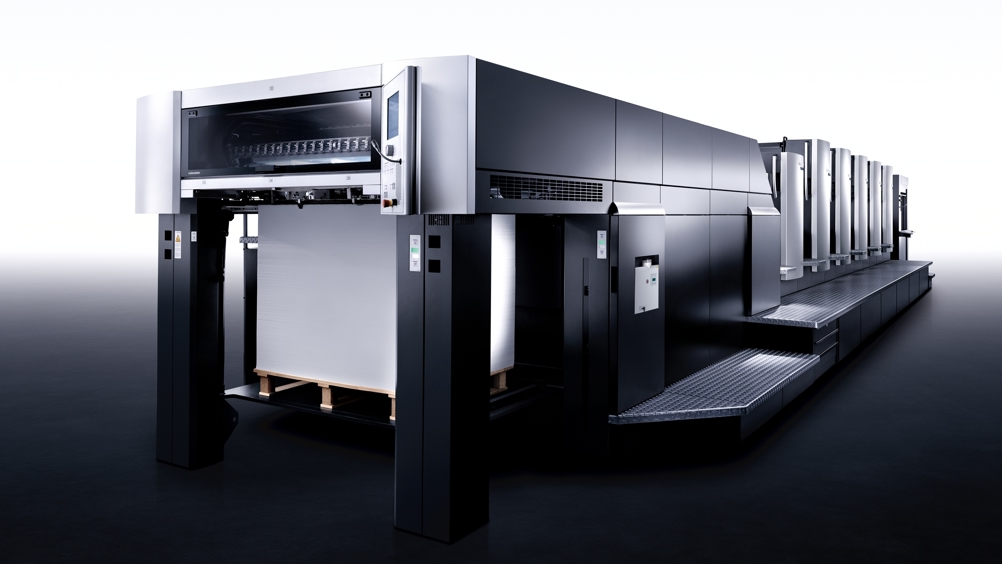What does it do?
It’s a 102cm-wide sheetfed offset press, the latest version of the Speedmaster CD series that was first launched by Heidelberg in the 1980s. This is Heidelberg’s best seller in China and doing well in Europe too. Although CD originally stood for Carton Druck, it is now regarded as a high-volume, very flexible general purpose simplex offset press with heavy stock capabilities. For perfecting there’s the XL 105 range.
Heidelberg offers most features as standard, with the options list reduced to about 20 items. Standardising these packages helps minimise build costs.
Standard configurations are available with coating unit, UV curing, automatic wash-up and the Preset Plus Delivery with various extension modules and dryer systems. For example, the DryStar Combination Carton with two slide-in modules for infrared/hot air and hot air has been developed for cartonboard printing. Format and air settings are made automatically with the Preset Plus Delivery.
When was it launched and what market is it aimed at?
The new CD 102 was announced in March 2014. Target users are “customers who make traditional advertising materials, packaging or labels”. According to Matt Rockley, marketing and product executive for sheetfed B1 & B2 at Heidelberg UK, it’s aimed at “any printer who wants to work with stock from 0.03mm to 1mm.”
How does it work?
It’s an offset unit press with double-size impression cylinders and triple-size transfer drums. This puts less stress on sheets of any weight. Between four and seven units can be specified.
How does it differ from previous models?
New side frames are used. The latest version adopts advanced automation systems originally developed for the Heidelberg XL series presses. This includes the Preset Plus feeders and pre-set delivery, plus the high power, high-efficiency driers, as well as XL grippers and bearings.
The new driers are 1.5m shorter than before, with more efficient heat/IR use that consumes less energy. Rockley says that a 20% drop in energy use is achieved if a coater is also fitted. UV curing units can be specified or retrofitted. The grippers require 20% less maintenance. Software from the XL series presses also helps with automation and reduces makeready times.
New Easy Control Colour spectrophotometer-based closed-loop colour control is fitted to the control desk, halving the previous cost of built-in colour management. It works with LAB values so is suited to special colours as well as process.
How fast is it?
Maximum speed is 15,000sph. The press is designed to handle 30m impressions per year and Rockley says that some customers are regularly hitting 50m.
What’s its USP?
Rockley says that the CD 102 has potentially the lowest cost per page of any B1 press. “It’s very reliable, with high utilisation. It changes plates very quickly and achieves high impression counts. We can prove this with our Analyse Point software and we offer free benchmarking to UK customers so they can check performance.”
How easy is it to use?
The Prinect Press Centre Compact user interface is fitted, which is the same platform as the XL presses. Rockley claims the CD 102 has the most automated feed and delivery system in the world. The Intellistart feature reduces the number of operator “footprints” around the machine.
What support is on offer?
Heidelberg claims that it has more trainers and service engineers than all its UK competitors put together, about 160 in total. However, 75%-80% of electrical problems can be solved remotely, Rockley says. It offers personalised operator training for new machines, tied to benchmarking, plus additional support at Heidelberg’s UK showroom in Brentford.
How much does it cost?
From £830,000 for a four-unit-plus-coater press with a high-spec factory package, including about 80% of the optional extras.
How many are installed?
More than 50,000 CD units have been sold worldwide since the mid-1980s. That’s around 10,000 presses. Rockley says Heidelberg is outselling all comparable B2 units in the UK by factors of 10s and 20s to one. “We’re selling one or two presses every week,” he says. There have been no UK installs of the new CD 102 yet.
SPECIFICATIONS
Max sheet size 720x1,020mm
Min paper size 340x480mm
Max print image 710x1,020mm
Stock thickness range 0.03–1mm
Max speed 15,000 sph
Number of units 4-7 simplex plus coater
Price From £830,000 for high-spec package with four units and coater
Contact Heidelberg UK 020 8490 3500 www.uk.heidelberg.com
ALTERNATIVES
Komori Lithrone GL-40
Komori’s family of B1 presses is available in a wide range of specifications and capabilities. Along with the GL-40 in the specifications here, there are packaging configurations, plus SX/GX models with larger sheet sizes up to 750x1,050mm.
Max sheet size 720x1,030mm
Min sheet size 360x520mm
Max print image 710x1,020mm
Min/max caliper 0.06–1.0mm
Max speed 16,500sph
Number of units 2-8
Price From about £820,000 with coater, extended delivery and IR drying
Contact Komori +31 30 248 2828 www.komori.eu
Manroland Sheetfed 700
Following Manroland’s break-up and takeover, it’s largely servicing existing presses rather than selling new ones. However the 700 is a modern press with plenty of automation, options for simplex, perfecting and carton work. The DirectDrive version was introduced in 2007, offering “dramatically” reduced makeready times.
Max sheet size 740x1,040mm (780x1,050mm optional)
Min sheet size 340x480mm
Max print image 715x1,020mm (770x1,030mm optional)
Min/max caliper 0.04 – 1.0mm (simplex); 0.04 – 0.6mm (perfector)
Max speed 16,000sph (simplex) 13,800sph (perfecting)
Number of units 6-12
Price TBC
Contact Manroland Sheetfed +49 (0)69 8305-0 www.manrolandsheetfed.com
USER REVIEW
“It is ideal for the work we do, advertising material using a wide range of stocks and materials, including boards. We have an advanced, automated and productive machine for a reasonable price.”
Urmas Savi Managing director of Aktaprint, Estonia











